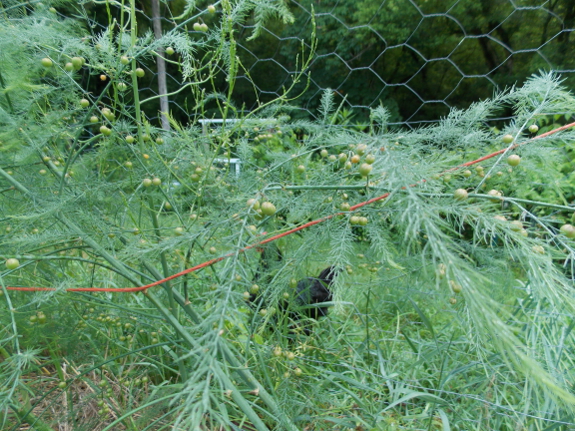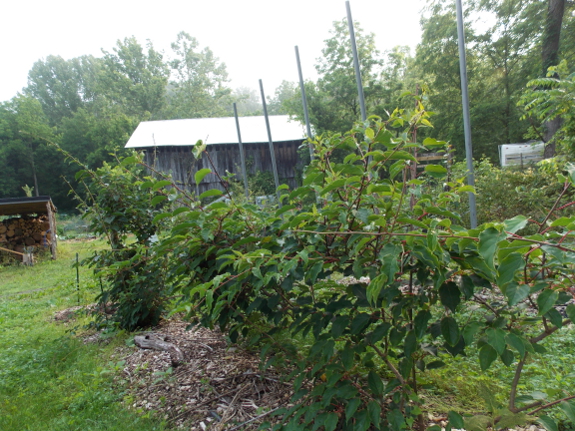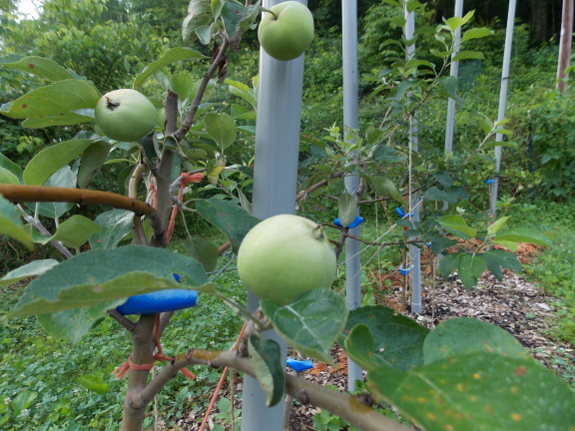
Perennial disapointments

Last fall, I wrote
that the offspring
of my all-male asparagus plants looked like they might be all-male
as well.
Less than half of the young plants had bloomed their first fall,
but every bloomer at the time was male. Unfortunately, it
turns out that only the males bloomed their first year, because
now asparagus alley is sporting lots of tiny green balls on the
feathery fronds. In fact, the planting turned out to be 60%
female! I could pull out the female plants now that they've
identified themselves and add some new seeds, but the truth is
that getting to eat asparagus next year from this planting trumps
higher yields in the long run for me, so I'll leave it
as-is. But it's a handy data-point --- saving seeds from
all-male asparagus doesn't necessarily give you any gender
advantage in the offspring.

Another problematic
perennial that's come to my attention this week is our hardy
kiwis. We
planted two females and a male in July 2008, and have been waiting
for fruits ever since. For years, I thought the problem was
late spring frosts that inevitably nipped back the kiwis' young
growth, but this year's cold spells missed all but the lowest
leaves...and still no blooms. Hardy kiwis are supposed to
fruit by year 5 at the latest, and this is year 6. Any
ideas, or will I be forced to pull out my elegant vines, to be
replaced with something more productive? I've got newly
rooted figs and gooseberries looking for a spot in the garden, so
the area won't go to waste, but I hate to give up on my dream of
homegrown kiwis.

Lest you think our
perennials are all depressing, I should note that several of our
apple trees seem to be keeping their
fruits.
In fact, apples on the Early Transparent (a variety that usually
ripens in late June in our neck of the woods) are starting to hang
pendant and to look like real apples! I can hardly wait to
taste apples from our own trees, and I'm thrilled that one of the
first will be a taste test of the same variety in a high
density method
versus in a forest garden environment.
Want more in-depth information? Browse through our books.
Or explore more posts by date or by subject.
About us: Anna Hess and Mark Hamilton spent over a decade living self-sufficiently in the mountains of Virginia before moving north to start over from scratch in the foothills of Ohio. They've experimented with permaculture, no-till gardening, trailersteading, home-based microbusinesses and much more, writing about their adventures in both blogs and books.
Want to be notified when new comments are posted on this page? Click on the RSS button after you add a comment to subscribe to the comment feed, or simply check the box beside "email replies to me" while writing your comment.

We started with two females (Anna) and one male, and they have never bloomed at the same time but we still get copious amounts of fruit. I have heard speculation from various kiwi folks that Anna does not require a pollinator, but I have never heard that from nursery owners... I purchased mine from One Green World 25 years ago. http://onegreenworld.com/
If you can get actual fruiting vines, you won't be disappointed, they are delicious and very prolific. The new growth gets nipped back here a little each spring by frost, but it doesn't seem make much difference. It might worth starting over with new plants.
Hi,
I have two female and one male kiwi plants. They are growing like crazy right now but just in their third year. Living in New England I was told it might take between 7 and 12 years for the fruit to come. Give it one more year at least, I have tasted friends hardy kiwi from their gardens. It is worth the wait.
Jason
I also have never had fruit from my kiwi vines after about 7 years. But just grew them from seed from shop bought fruit (Fuzzy Kiwifruit (A. deliciosa), not Hardy Kiwi (A. arguta)) I thought maybe not enough chill hours here. It does seem to be a common problem though. I think I did read that pruning back hard can sometimes work.
I think our hardy kiwis were about 7 years old when they first bore fruit. If an late spring frost gets the leaves, they don't have the energy to put out new leaves and also bear fruit until the vines get older. We have two Annas, two males and a Michigan State. We usually get fruit every 2 or 3 years because of late frosts. We've got blooms this year! Interesting about Anna being self-pollinating! I hope so because we've got very few blooms on our males this year.
If I were you, I would leave the kiwis in place and give them more time. The fruit is worth the wait. MI State is smaller and sweeter than Anna, which is delicious.
My plants came to me from Miller Nurseries. Jack from the Survival Podcast suggested a few different mail order nurseries during a show two or three years ago. Miller was one of them. Their literature says first fruit in 5-7 years but it was a local permaculturist who said 7-12 years. By the way I enjoyed when you guys were on the Survival Podcast. Two of my world collided and it was a great episode.
Jason